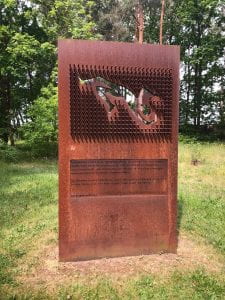Sachsenhausen:
On our first day in Berlin, we visited Sachsenhausen concentration camp, which housed over 200,000 prisoners between 1936 and 1945. This concentration camp was not built purely for people of the Jewish faith, but for general enemies of the Nazi ideology, anybody they didn’t like, and anybody who didn’t like them. The former camp, now museum, did nothing to hide the murderous Nazi intent or the crimes that were committed there, thereby highlighting both the Nazi brutality and the recent German apologetic stance on the Holocaust.
Since World War II ended, Germany has apologized profusely for the Holocaust and the war in general. It has owned up to what it did and has been up front about the horrific things that happened during the war. This is shown in how truthful the museum at Sachsenhausen was. The museum did not shy away from detailing the tortures that occurred there, nor the forced labor, nor the sex slaves, killings, or crematoria. Many of these details were gruesome, accompanied by photos or drawings, giving the reader an accurate picture of the atrocities that went on. Prisoners went through unbelievably brutal experiences, including torture (such as being hung by their wrists), forced marches to test military footwear, food deprivation, extremely tight living spaces, death marches, and beatings.


Pictures of some of the tortures the SS would enjoy inflicting on the prisoners. Prisoners were hung from the wood poles in such a position that their shoulders were dislocated. Many died from tortures like this.
Describing these horrid actions brings to light Germany’s truthfulness, its owning up to its hateful past, denying nothing about its fateful decisions and criminal actions. They have given a lot of effort in changing the world’s perception of their country, making great strides to heal their country and separate today’s Germany from Nazi-ruled Germany.

As a sign of penitence, the words of former prisoner Andrzej Szczypiorski are inscribed at the camp today: “And I know one thing more – that the Europe of the future cannot exist without commemorating all those, regardless of their nationality, who were killed at that time with complete contempt and hate, who were tortured to death, starved, gassed, incinerated and hanged…”.
Walking through the camp itself was a somber experience, forcing me to reflect on what happened here. Everywhere I walked or stood, thousands of prisoners had walked or stood before me, and in more pain than I will ever know. That knowledge brought a crushing weight upon me; I couldn’t help but think of the thousands who suffered right where I was standing, the hundreds who had been killed right where I was walking. The reality of the murderous Nazi cruelty stuck with me through the end of the day, an almost draining feeling. Countless times walking through the camp I thought to myself and questioned how this insane magnitude of hate and murder could have happened. I was confused how anyone could commit such violence every day and act like it’s normal, and I am not sure I will ever understand. However dreadful it felt to walk through such sadistic history, it is important to experience it, to see with one’s own eyes the barracks the prisoners were held in, the crematoria where the dead were burned, the wooden stakes where prisoners were held aloft by their wrists; to hear accounts of prisoners who witnessed the unthinkable; to see how indifferent the SS soldiers were to the suffering of others. This is important with respect to the German memory of the history; it must be so that it can never be forgotten.
Modern Germany has done a great job at distancing itself from Nazi Germany. In fact, the heroes of World War II that Germany now idolizes were the people who tried to assassinate Hitler. One of the earliest assassination attempts was undertaken by Georg Elser, who failed and was imprisoned in Sachsenhausen until 1945. He was then transferred to Dachau and shot under order by Hitler. Now considered a hero, Georg Elser is memorialized at Sachsenhausen:

Inscription on his memorial: “… He was a few minutes short of changing the course of history. Commenting on his deed, George Elser said “I wanted to prevent the war”… With this memorial stone, we honour a man who recognized the criminal intentions of the Nazi Party earlier and more clearly than most of his compatriots. His deed ranks him among the important German resistance fighters – and his name must never be forgotten…. “
Elser wasn’t the only one to get a memorial there, however. There was an area at Sachsenhausen where family members or groups could put up their own memorials to people or groups of prisoners who were sent there. I was moved by this part of the museum, because it showed that each individual killed at this camp, and every other camp, had his or her own story. There were around 80,000 to 100,000 deaths at Sachsenhausen, but looking at this memorial section reminds one that every one of those 80,000 prisoners who died, every one of the 200,000 inmates had a family who loved them, friends who cared for them, an entire life that could have been.
Some of the memorials:




Reads: “We remember August Dickmann (Born 1910), one of Jehovah’s witnesses, who on September 15, 1939, became the first conscientious objector to be publicly shot by the SS.”

Translates to: “In memory of Wlodzimierz Dlugoszewski (1905-1945), Captain of the Polish Rowing Team which won the Bronze Medal at the 1936 Olympic Games in Berlin.”

Reads: “In memory of the great North Frisian poet Jens E. Mungard, 9 February 1885 – 13 February 1940. He bravely trod his own path. The Frisians’ freedom he held aloft. He had to die for it at the Sachsenhausen concentration camp.
Sea holly is my bloom, they call me sea holly too.
She grows on the dunes’ sand, as I upon life’s strand,
and both of us have thorns!”







